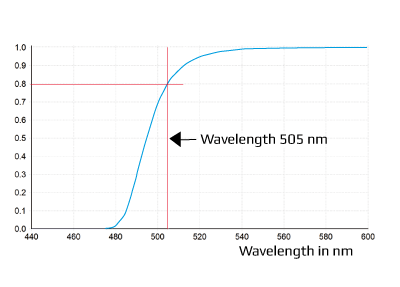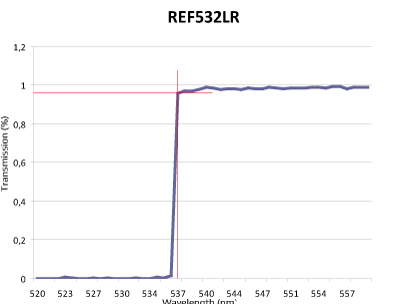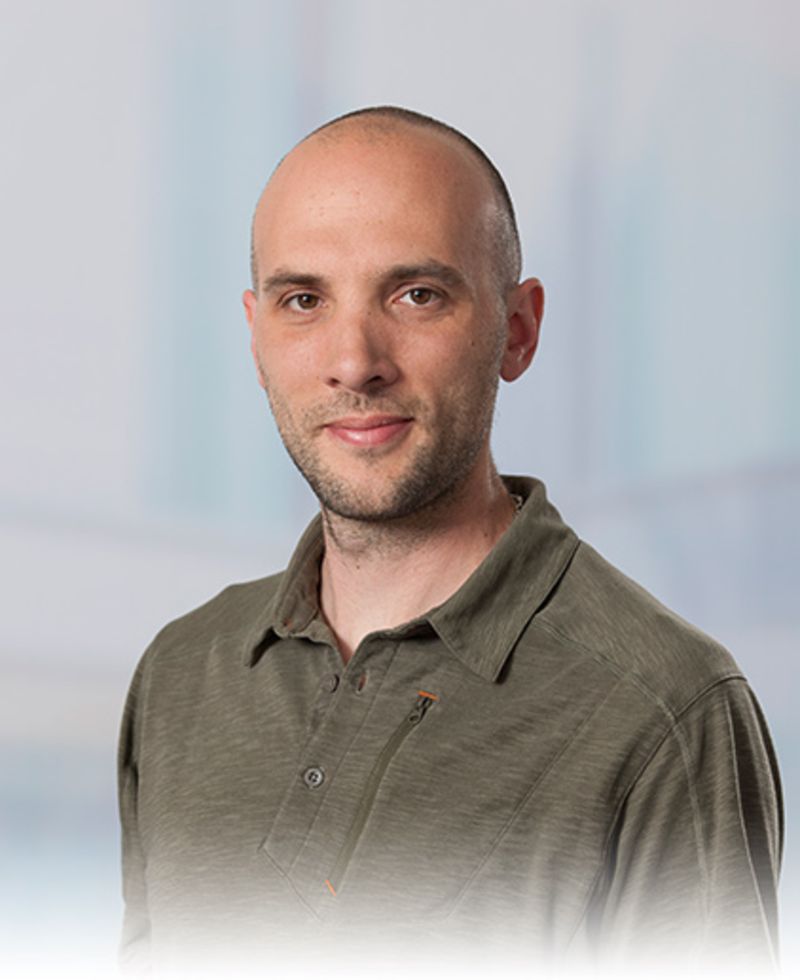How do I find the right filter for my particular application and what is the difference between them? (Part 1)
Thanks to modern technology, there is a wide range of different long, short and band pass filters available today. However, they all look pretty much the same.
What is the difference?
Let us start with long pass filters. They block light to a certain wavelength and let light with a longer wavelength pass. The area where the filter blocks the light is called blocking range and the area where it transmits is called transmission range.
The wavelength from which on the filter is transparent is called the cut-on wavelength. Normally, the cut-on wavelength given is the wavelength where filters have either 5% (5% cut-on) or 50% (50% cut-on) transmission. If you know both parameters, you can determine the number of nanometers it takes for the filter to go from 5 to 50% transmission. This range is called the edge width and tells you in which range the filter neither blocks nor transmits well.
One major difference between the filter types is the edge width.
Let us try to illustrate this by choosing a more every day example. If filters were cars, the edge width would indicate how “fast” it accelerates from 5 to 50 or from 5 to 80 mph. And just like with cars, this is what makes the real difference between the different models.
Surely you’ll remember the VW Beetle. It was a reliable little car with lots of charm but only little power. The Beetle represents the widely known and most basic color glass filters. They are simple, robust (no coating), cost-effective and suitable for a wide range of basic applications. However, they do need 40 - 60 nm (depending on the type) to get to full “speed”. Like your average low speed car that looks like a speed machine when it’s all shiny and freshly polished, your standard color glass filter appears more than it is in most catalogs and illustrations. This is because a logarithmic scale is used to show the transmission as a function of wavelength. If a linear presentation is chosen, things look quite more realistic.
Color glass filters are suitable for temperatures to 100°C. They are easy to clean and easy to use. They can be used to create the basic colors blue, yellow, green and red and as monochromator order sorting filters. Be careful when using them in fluorescence spectroscopy. Color glass filters show autofluorescence, especially when excited in the UV.
Figure 1 shows the typical edge width of our color glass filter.
The average middle class car can reach full speed in approximately 12 to 15 seconds.
The basic version of the next better dielectrically coated long pass filter combines color glass (which is important for the basic blocking) and glass that is dielectrically coated and which provides a steeper slope. This type of filter needs about 20 nm to get from 5 to 80 %.
For example model XXXFH90
5% / 50%: typically 10 nm - 15 nm
5% / 80%: typically 20 nm - 25 nm
QD Europe offers filter models that correspond to everything from faster middle class models over speed-oriented sportsters and highly tuned hot rods all the way to Ariane-like rockets.
Fig. 2 shows the typical curve of a very steep Raman edge filter.
Fast – faster – the fastest...
Last but not least we present to you a filter that has been developed for a special research project: the Ariane rocket! From Korou to the designated orbit in only seconds… Or in other words:
The edge width from OD3 (full blocking) to full transmission is only 1.6 nm!
Edge width of purely dielectrically coated long pass filters which are mainly used in fluorescence and Raman spectroscopy:
| Model EXXXLP | 5% / 50% typ. 3 - 5 nm 5% / 80% typ. 5 - 10 nm |
| Model HQXXXL | 5% / 50% typ. 1 - 2 nm 5% / 80% typ. 10 - 15 nm |
| Model HHQXXXL | 5% / 50% typ. 1 - 2 nm 5% / 80% typ. 5 - 8 nm |
| Model ETXXXL | 5% / 50% typ. 1 nm 5% / 80% typ. 3 nm |
| Model REFXXXL | 5% / 50% typ. 1 - 1.5 nm 5% / 80% typ. 3 - 5 nm |
| Model REFUSXX | 5% / 80% typ. 1 - 2 nm |
Apart from long pass filters, there are short pass, band pass and notch filters. All of these will be introduced to you in a follow-up article in our next Spectrum.





